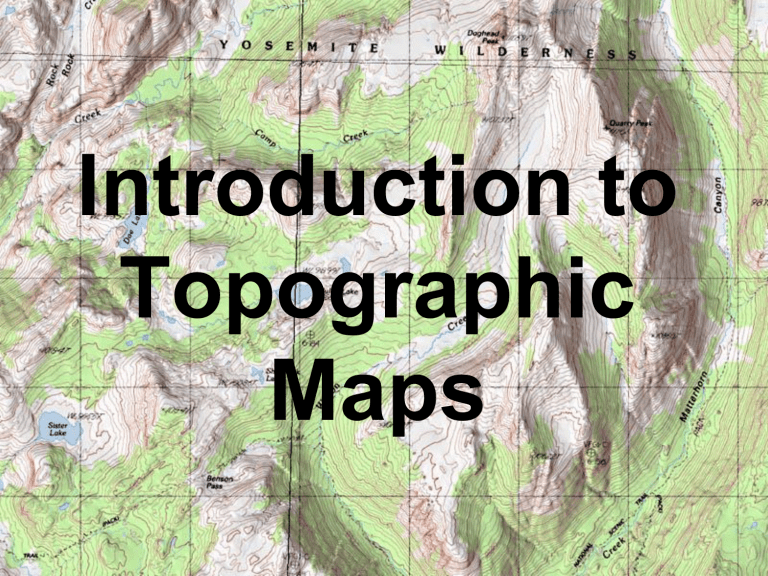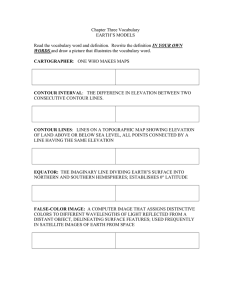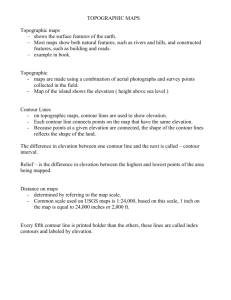
Introduction to Topographic Maps Topographic Maps • Two dimensional model of the Earth’s surface (represents 3-D world) • Topographic maps are also known as contour maps. • Show elevation above sea level using contour lines. “Real World” Contour Map Topographic Maps • Contour Line – - line on a map that connects points of EQUAL elevation. - show elevation and shape of the land • Relief – Difference between high and low elevations Topographic Maps • Contour Interval – difference in elevation between each line. MUST be equal spacing. Contour interval = 20 feet 580 560 540 520 Topographic Maps • Index Contour – Usually every 5th line is printed darker and has an elevation printed on it. Rules for Contours 1. Contour lines never cross Rules for Contours 2. Contours form closed loops (even if not shown of the map. Rules for Contours 3. Contours bend upstream (uphill) when crossing a stream. The direction of a river can be found on a topographic map three ways: 1. Contour lines bend upstream- All rivers flow downstream. 2. Look at the elevation the river flows through. Rivers flow downhill or from High elevation to a Low elevation. 3. Streams and rivers tend to flow into oceans or lakes Mill River generally flows toward the North East Rules for Contours 4. The maximum possible elevation for a hill is “1” less than what the next contour “should” be. 90 The highest possible elevation of the hill is just below the value of the next line that is not shown 80 70 60 50 399 179 239 Closely Spaced Contours • Steeper Slope (Gradient) – contour lines are closer together. Wide Spaced Contours • Gradual/Gentle Slope (Gradient) – contour lines are farther apart. A B Depressions • Contour lines which show a depression, crater, or sinkhole on a map. • Shown by dashed lines (hachure marks) on the inside of a contour line • The elevation of the first depression contour is the same as the lowest regular contour near it. Rules for Contours The lowest possible elevation for a depression is “1” more than what the next contour “should” be. 90 90 80 The lowest possible elevation of a depression is just above the value of the next line that is not shown 51 70 60 50 What do hachured lines show? Areas of depression: such as a lake or top of volcano What are the rules concerning hachured lines? The 1st hachured line has the same elevation as the previous contour line Benchmarks • a location whose exact elevation is known and is noted on a brass or aluminum plate. • benchmarks are shown on maps by an X with the letters BM written next to them. Map Scales • Indicates the distance on the map compared to distance in the real world • Graphical - by a line divided into equal parts and marked in units of length. Let’s take a walk up a hill! We’re now at an elevation of 100 meters. 100m Let’s keep going! 100m Now we’re at 200m. 200m 100m Shall we march on? 200m 100m We’ve made it to 300m! 300m 200m 100m On to the peak! 300m 200m 100m We’re on the peak, but what’s our elevation? 300m 200m 100m Any ideas? Let’s add contour lines for every 50 meters and see if that helps. 300m 200m 100m We know that we are above 350m, but less than 400m. 350m 300m 250m 200m 150m 100m 50m Let’s head down the hill, it’s getting late! 350m 300m 250m 200m 150m 100m 50m Now what’s our elevation? If you said somewhere between 200m and 250m you are right! 350m 300m 250m 200m 150m 100m 50m Let’s try this again! 350m 300m 250m 200m 150m 100m 50m What’s our elevation now? If you said 50m or just under, you’re right! 350m 300m 250m 200m 150m 100m 50m Let’s now look at the same hill, but the way we might see it from an airplane! Each color change represents a 50 meter increase. Now, let’s try the same hike! Our elevation is 0 meters. Now what is our elevation? If you said more than 150 meters, but less than 200 meters your right! Let’s go a little higher. Think you know our elevation now? More than 300meters But less than 350meters If we were standing on the peak, what would be our elevation? • More than 350 meters, less than 400 meters Let’s head down hill. Know our elevation? More than 100 meters, less than 150 meters Gradient • The slope between any two points on a hill • Gradient = Change in Field Value Distance Gradient • A trail is four miles long as measured by the scale on a map. The beginning of the trail is at the 1,060 ft contour line and the end of the trail is at the 960 ft contour line. Calculate the gradient of the trail. Gradient = 1060 ft – 960 ft 4 miles = 25.0 ft/mi Gradient Contour Interval = 20 ft 200 0 2 4 miles 6 8 10




